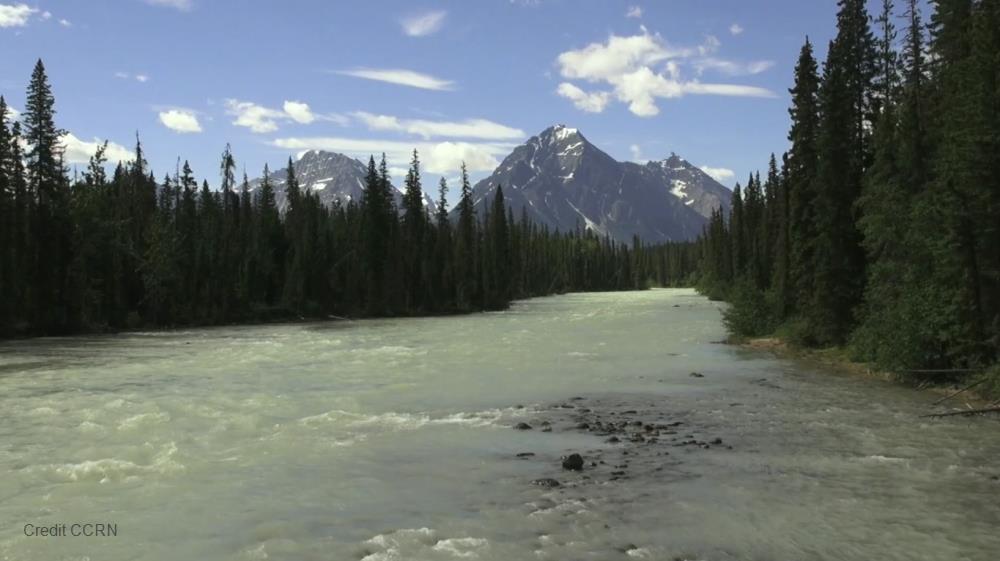The Wolf Creek basin forms part of the southern headwaters of the Yukon River, among mountains some 20km south of Whitehorse. The basin drains an area of approximately 195km², ranging in elevation from 800 to 2250m, with the median at 1325m, and a general north-easterly aspect.
The basin is situated within the Boreal Cordillera ecozone (Environment Canada, 1995), and consists of three principal ecosystems; boreal forest (22%), sub-alpine taiga (shrub-tundra) (58%), and alpine tundra (20%). Permafrost is present on north facing slopes and sporadically throughout the basin, with prevalence increasing with elevation.
The sub-arctic continental climate is characterized by wide seasonal variation in temperature, low relative humidity and relatively low precipitation. Mean annual temperature is approximately -3ºC, with summer monthly ranges of 5ºC - 15ºC, and and winter monthly ranges of -100ºC to -20ºC. Summer and winter extremes of 25ºC and -40ºC are not uncommon. Mean annual precipitation is 300 to 400 mm per year, with approximately 40% of this falling as snow.
Three micrometeorological stations (Alpine Tundra, Buckbrush Taiga, and White Spruce Forest) were established to collect and store weather and soil data. A hydrometric station located at the Wolf Creek basin outlet nearby the Alaska Highway was used to record the basin discharge. Several additional sites were also established in a sub-basin (the Granger Basin, approximate area 4.3 km²), in order to study energy and water balances on sloped surfaces. Three sub-basins are gauged for streamflow.
Alpine Tundra met station
Location: 60°34.04 N 135°08.98 W
Elevation: 1615 m
Area represented: 39 km² (20% of basin total)
Description: Windswept, high alpine tundra plateau along the drainage divide at the northern edge of the basin. Approximately 50% of the site is relatively level, with the balance sloping at approximately 15º to the south. A reasonably level fetch extends for several hundred meters to the north, south, and west. A rounded hilltop (35m) rises about 50m to the east. Vegetation is sparse and consists of mosses and lichens with occasional patches of scrub willow and birch no more than 20 cm tall. Boulders up to 1m tall are scattered on the plateau. Soils are lichen moss organic for the top 3cm, with a rocky/bouldery mineral soil below.
Buckbrush Taiga met station
Location: 60°31.34 N 135°11.84 W
Elevation: 1250 m
Area represented: 113 km² (58% of basin total)
Description: Located on an east-facing moderate hillslope of approximately 15º, near the bottom of the valley between Mt Granger and Coal Ridge, on a drainage divide between the Coal Lake Basin and the highest headwater of Mt Granger. A sloping fetch extends NE and SW for several kilometres. To the NW, the valley slopes upwards and to the SE the valley drops somewhat before rising to Coal Ridge. The hillslope itself consists of undulating terrain with numerous hummocks and depressions. Vegetation is bushy, consisting of tall willows and alders (1-3 m) with sparsely scattered spruce (spaced about 100 m apart). Top 6cm of soil is moss organic, with an alluvial fan of rocks and silt below.
moss organic, below this an alluvial fan of rocks and silt.
The station comprises a 5.2m tower micrometeorological array, using solid state Campbell Scientific Inc dataloggers with data-storage modules. Power is supplied by 12V DC batteries, charged by solar modules.
White Spruce Forest met station
Location: 60°35.76 N 134°57.17 W
Elevation: 750 m
Area represented: 43 km² (22% of basin total)
Description: The study area includes three data-collection sites on a relatively level valley bottom, set in dense canopy of mature white spruce forest (12 - 18m) with some poplar trees (to approximately 15m), close to the Wolf Creek basin outlet. The terrain undulates gently, consisting of an alternating hummock and hollow landscape. The forest extends in all directions, except for the area occupied by the Whitehorse Cadet Camp, some 50 m NE of the Site 1 mast. A 10m wide clearing 15m west of the Site 3 tower allows for canopy-free precipitation measurements. Soils are
moss organic in the top 10 - 15cm, underlain by silt loam to 1.4m, with river gravel below this.
The towers are 22m and 15m tall, with a micrometeorological sensor array writing to solid state Campbell Scientific Inc dataloggers with data-storage modules. Power is supplied by 12V DC batteries, charged by solar modules.
Wolf Creek Research Basin website:
http://www.wolfcreekresearchbasin.ca


 GWFNet
GWFNet Master
Master Data
Data Research
Research Map
Map
 Advanced
Advanced Login
Login

 Metadata Editor
Metadata Editor
 Record List
Record List
 Alias List Editor
Alias List Editor
 Legacy sites
Legacy sites